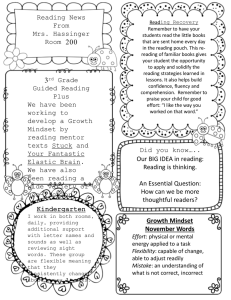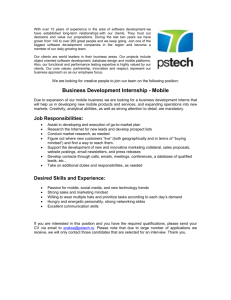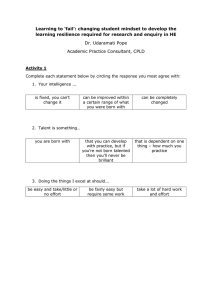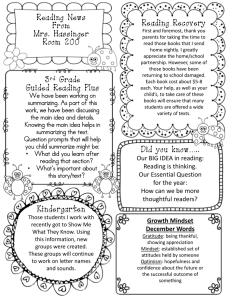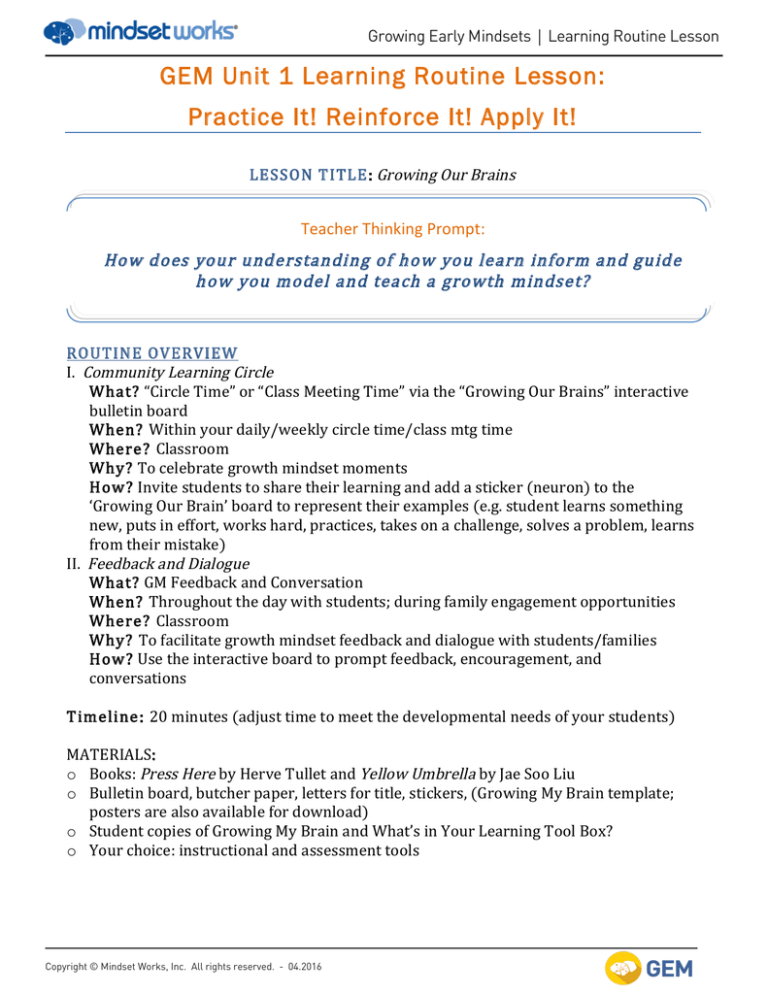
Growing Early Mindsets | Learning Routine Lesson
GEM Unit 1 Learning Routine Lesson:
Practice It! Reinforce It! Apply It!
LESSON TITLE: Growing Our Brains Teacher Thinking Prompt: How does your understanding of how you learn inform and guide how you model and teach a growth mindset? ROUTINE OVERVIEW I. Community Learning Circle What? “Circle Time” or “Class Meeting Time” via the “Growing Our Brains” interactive
bulletin board When? Within your daily/weekly circle time/class mtg time Where? Classroom Why? To celebrate growth mindset moments How? Invite students to share their learning and add a sticker (neuron) to the ‘Growing Our Brain’ board to represent their examples (e.g. student learns something new, puts in effort, works hard, practices, takes on a challenge, solves a problem, learns from their mistake) II. Feedback and Dialogue What? GM Feedback and Conversation
When? Throughout the day with students; during family engagement opportunities
Where? Classroom
Why? To facilitate growth mindset feedback and dialogue with students/families
How? Use the interactive board to prompt feedback, encouragement, and
conversations
Timeline: 20 minutes (adjust time to meet the developmental needs of your students) MATERIALS: o Books: Press Here by Herve Tullet and Yellow Umbrella by Jae Soo Liu
o Bulletin board, butcher paper, letters for title, stickers, (Growing My Brain template;
posters are also available for download)
o Student copies of Growing My Brain and What’s in Your Learning Tool Box?
o Your choice: instructional and assessment tools
Copyright © Mindset Works, Inc. All rights reserved. - 04.2016
PREPARATION: Designate a wall space for the “Growing Our Brains” bulletin board. Print the Growing Our Brains posters from website; laminate and add to board; and add title. If space is limited, use the Growing My Brain template, laminate, and use on a clipboard during instruction. *If/when the visual gets “full”, add another brain poster and talk about our brain’s
unlimited capacity to grow smarter and stronger.
More Ideas to Represent How the Brain Grows o Jellybean Jar – add a jellybean (neuron) to a jar to represent an example of
student learning; accumulate jellybeans over a period of time to demonstrate
“growth”
o Penny Jar – add a penny (neuron) to a jar to represent an example of student
learning; accumulate pennies over a period of time to demonstrate “growth”;
explore Unit 7 Service Learning Projects to learn how to use the pennies for a
service learning opportunity
PROCEDURE I. INTRODUCE IT! CONNECT IT!
A. Preview: Essential question, learning goals, and purpose of the bulletin board
B. Activate background knowledge (whole/small group discussion,
think/pair/share, journal):
What does our brain do? (e.g. functions of your brain)
Do our brains grow? How? (e.g. thinking, learning something new, trying to do
something a little hard, practicing, working hard, solving problems, and learning from
mistakes)
II. REINFORCE IT!
A. Read-­‐Aloud: Press Here by Herve Tullet and/or Yellow Umbrella by Jae
Soo Liu
1. Engage students in a book walk.
2. Read books for enjoyment, to engage student interest, and to share a visual of what
the inside of the brain looks like growing.
3. Think-­‐Aloud (while progressing through the pictures): This is what our brain
looks like when it’s growing. Each little “dot” (or “umbrella”) is like a neuron in our
brain. Every time we learn something new, try to do something a little hard, practice,
work hard, solve a problem, or learn from a mistake our neuron connections grow
stronger and our brain grows smarter.
B. Prompt thinking (think/pair/share): What do you know how to do already?
What do you want to learn how to do?
Copyright © Mindset Works, Inc. All rights reserved. - 04.2016
III. MODEL IT! PRACTICE IT!
*Cycles apply to the cycle implementation. For single implementation choose one
of the cycles.
Cycle 1 (Day 2, Week 1) Routine: Introduction/Modeling
1. Introduce ‘Growing Our Brains’ bulletin board; share with students examples of
your learning; use stickers to represent the neurons which grow as a result of
learning and attach to the “brain” on the board.
Think-aloud: “Learning makes your brain grow like this. Each sticker is like a
new brain cell (share diagram of neuron – Unit 2) growing in our brain. Our brain
cells are called neurons.”
2. Invite students to share an example of their past learning (e.g. walking, talking,
jumping, writing name, riding a bicycle, learning a language, skateboarding,
counting, adding, singing, reading, playing an instrument, dancing); use stickers
to represent the neurons which grow as a result of learning and attach to the
“brain” on the board.
Think-aloud: “Learning makes your brain grow like this. Each sticker is like a
new brain cell (neuron) growing in our brain.”
3. Activate previous lesson’s learning: Learning Tool Box (Anchor Book Lesson) and
invite students to write and/or draw what is in their ‘Learning Tool Box.’
4. Invite students to share their thinking/observations (whole/small group
discussion, think/pair/share, one/one conferences, journal):
“When I look at the board and/or my learning tool box, I see/notice/think _____.”
Routine: Guided and Collaborative Practice
Cycle 2 (Day 2, 1. Invite students to share thinking/observations of bulletin board (from cycle 1):
Week 10) “When I look at the board, I see/notice/think ________.”
2. Introduce ‘Growing My Brain’ student copies; demonstrate the growing of neurons
by adding mini stickers to represent neuron growth.
Think-aloud: “You’re learning _______.” “You’re practicing ________.” (add a
sticker for each example)
3. Invite students to share additional examples of learning; add to the template.
4. Invite students to work in pairs to add stickers to their ‘Growing My Brain’ board
and name what “learning” each sticker represents to their partner. Examples: “This
neuron grew when I practiced writing my name.” “This neuron grew when I read
___________.” “This neuron grew when I learned a new word.” “This neuron grew
when I practiced counting by fives.” “This neuron grew when I took turns at
recess.” “This neuron grew when I solved the problem with my friend.” Provide
scaffolding throughout activity.
5. Invite students to share their thinking/observations (whole/small group
discussion, think/pair/share, one/one conferences, journal):
“When I look at my ‘Growing My Brain’ board, I see/notice/think __________.”
Copyright © Mindset Works, Inc. All rights reserved. - 04.2016
Routine: Independent Practice and Reflection
Cycle 3 (Day 2, 1. Invite students to share thinking/observations of bulletin board and their ‘Growing
Week 19) My Brain’ boards (from cycle 1 and 2):
“When I look at the board, I see/notice/think ____________.”|
“When I look at my ‘Growing My Brain’ board, I see/notice/think _________.”
2. Invite students to add more examples of their learning (e.g. stickers).
3. Invite students to engage in the Bloom’s Taxonomy of Questions for Reflection
(whole/small group discussion, think/pair/share, one/one conferences, journal).
*Scaffold according to developmental appropriateness.
Routine: Sharing and Reflection
Cycle 4 (Day 2, 1. Invite students to share their ‘Growing My Brain’ boards with their peers:
Week 28) “When I look at my ‘Growing My Brain’ board, I see/notice/think __________.”
2. Invite students to engage in the Bloom’s Taxonomy of Questions for Reflection
(whole/small group discussion, think/pair/share, one/one conferences, journal).
*Scaffold according to developmental appropriateness.
IV. CHECK IT! REFLECT ON IT!
A. Think/Pair/Share: Share with your neighbor an example of your learning.
B. Formative Assessment Opportunities: Bloom’s Taxonomy of Questions for
Reflection (whole/small group discussion, think/pair/share, one/one conferences,
journal, exit slip) and Quote Journal
Copyright © Mindset Works, Inc. All rights reserved. - 04.2016
Growing My Brain
The more you learn today, the smarter you are tomorrow.
Name ______________________________ Date _____________
Copyright © Mindset Works, Inc. All rights reserved. - 04.2016
What’s in Your Learning Tool Box?
The more you learn today, the smarter you are tomorrow.
Name _______________________________ Date ____________
My Learning
Tool Box
Copyright © Mindset Works, Inc. All rights reserved. - 04.2016
About Mindset Works
Mindset Works was co-founded by one of the world’s leading researchers in the field of
motivation, Stanford University professor Carol S. Dweck, Ph.D. and K-12 mindset expert
Lisa S. Blackwell, Ph.D. The team translates psychological research into practical programs
and services to help students and educators increase their motivation and achievement.
Visit www.mindsetworks.com/free-resources for more growth
mindset resources, tools, articles, and lessons.
Contact us at info@mindsetworks.com for information about our
programs and services.
Mindset Works and Brainology are registered trademarks of Mindset Works, Inc.

